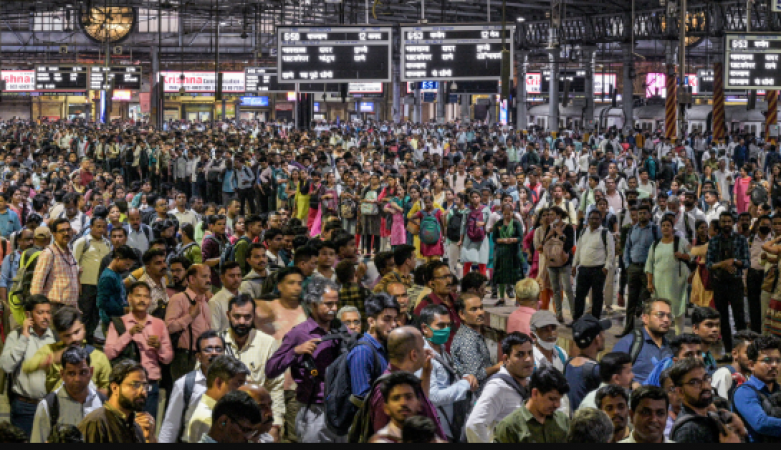
New Delhi: According to data released by the UN on Wednesday, India is on track to overtake China as the world's most populous country by mid-2023. This raises the question of whether India's rapidly growing and largely young population will support economic growth for years to come or become a liability.
China is battling an ageing population and stagnant population growth, whereas India has the largest population of people between the ages of 15 and 24 at 254 million. Expectations have grown that India may soon surpass other major economies as a global power. This is because of the demographic changes.
Young people in India could be the engine of the nation's economic growth for years to come, but they also run the risk of becoming a problem if they aren't properly employed. The economy of India is among the fastest-growing as its population rises, but economists have cautioned that unemployment has also increased.
Also Read: Watchdog warns that US funding may be going to the Taliban
In order to shift some of its production out of China, where wages are rising as the country's population of people of working age is declining, tech giant Apple, among other businesses, hopes to turn India into a potential manufacturing hub.
According to the UN report, India will surpass China in population size by about 2.9 million people by the middle of this year. According to UN estimates, India will have 1.4286 billion people at that time compared to mainland China's 1.4257 billion. Since India last conducted a census in 2011, demographers claim that the limitations of available population data make it impossible to determine an exact date.
Since at least 1950, when the UN started publishing population statistics, China has had the largest population on earth. With a combined population of more than 1.4 billion, China and India account for more than one-third of the world's 8 billion inhabitants.
India's rise to the top spot in terms of population was once predicted to occur later in this decade. However, a decline in China's fertility rate and fewer children being born into families has accelerated the timing.
Also Read: The Xiaomi 13 Ultra Xiaomi's newest flagship phone has been unveiled
In contrast, India's population is considerably younger, it has a higher fertility rate, and over the past 30 years, infant mortality has decreased. Nevertheless, according to World Bank data, the nation's fertility rate has been steadily declining, from more than five births per woman in 1960 to just over two in 2020.
Since the country's declaration of independence 76 years ago, its population has more than quadrupled. India, which is on track to surpass China as the largest nation in the world, is battling a widening religious divide, a serious urban-rural divide, severe economic disparities between men and women, and the threat of climate change.
In a survey of 1,007 Indians conducted by the UN in conjunction with the report, 63% of participants said that when they thought about population change, economic issues were their top concern, followed by concerns about the environment, health, and human rights.
The results of the Indian survey imply that widespread public anxiety about the population has crept in. However, population figures shouldn't be a cause for concern or alarm, according to Andrea Wojnar, the UNPF's representative for India.
They ought to be viewed as a sign of advancement and development, she continued, "if individual rights and choices are being upheld."
A "demographic dividend," or the potential for economic growth when a country's young population surpasses its share of older people who are beyond their working years, is what many people are betting on India's rising number of people in working age to give it. It is what enabled China to solidify its position as a superpower.
We haven't been able to fully capitalise on our demographic dividend thus far. According to Mahesh Vyas, director of the Centre for Monitoring the Indian Economy, employment has not increased while the working age population has increased significantly.
He continued by saying that the nation has struggled to increase employment over the past six years, with the number of jobs remaining unchanged at 405 million.
From an underdeveloped country in 1947 to an emerging global power with Asia's third largest economy, India has undergone a phenomenal transformation. It is a significant exporter of goods like software and vaccines, and as its high-skilled industries have grown, millions of people have been able to escape poverty and join a growing, aspirational middle class.
But so too has unemployment. CMIE data from 2022 shows that only 40% of Indians who are working age are employed.
The head of the Population Foundation of India, Poonam Muttreja, agreed that the nation needed to make better plans for its youth.
Also Read: Pope Francis presents King Charles with shards of Christ's cross for Coronation
"This large population will require a significant investment in skills in order to take advantage of the employment opportunities that will arise in the economy. But we also need to create more jobs for them, she added, noting the importance of making investments in education.
The spokesperson for China's foreign ministry, Wang Wenbin, stated on Wednesday in response to news of the UN report that "a country's demographic dividend depends not only on quantity but also on quality."
"Talent is important, but so is the population... Wang stated at a briefing that China's demographic dividend has not vanished, the talent dividend is occurring, and development momentum is still strong.